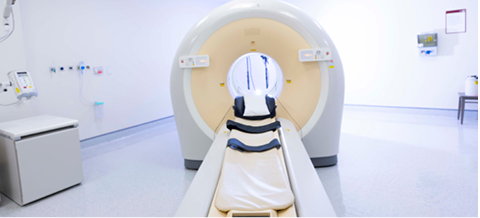PET-CT and SPECT-CT
The SPECT-CT and PET-CT imaging technologies at Burjeel Medical City provide advanced diagnostic tools to detect, stage, and monitor a wide range of medical conditions. These hybrid imaging systems combine nuclear medicine with computed tomography (CT), offering highly accurate detection of physiological activity and providing detailed anatomical information. These technologies are crucial for guiding treatment decisions, tracking disease progression, and assessing responses to therapies across multiple medical specialties.
Key Features.
Early Detection
PET-CT, in particular, detects changes in the metabolic activity of cells, allowing for earlier detection of abnormalities, improving diagnostic outcomes across various conditions.
Functional and Anatomical Imaging
Both modalities allow physicians to visualize metabolic changes in cells and precise anatomical details in a single scan, enhancing diagnostic accuracy and ensuring effective treatment planning.
PET-CT (Positron Emission Tomography-Computed Tomography)
Provides highly sensitive imaging by combining PET and CT scans, offering detailed images of tissue activity and anatomical features.
SPECT-CT (Single Photon Emission Computed Tomography-Computed Tomography)
Often used to detect and monitor conditions such as cardiovascular disease, neurological disorders, and musculoskeletal issues.
Combines nuclear medicine and CT to provide both functional and anatomical imaging, making it useful for detecting abnormal activity in bones, organs, and soft tissues. Used for diagnosing conditions like bone infections, joint inflammation, neurological disorders, and vascular problems.
Conditions Diagnosed and Monitored with SPECT-CT and PET-CT SPECT-CT and PET-CT.
These imaging systems are used to diagnose, stage, and monitor various medical conditions, including:

- Cardiovascular diseases (e.g., heart disease, vascular conditions)
- Neurological disorders (e.g., Alzheimer’s, epilepsy, stroke recovery)
- Musculoskeletal conditions (e.g., bone infections, arthritis, bone fractures)
- Endocrine disorders (e.g., thyroid disease, parathyroid issues)
- Infections and inflammation (e.g., osteomyelitis, septic arthritis)
- Spinal conditions (e.g., spinal infections, degenerative disc disease)
- Liver and kidney diseases
- Cancer monitoring and staging (for various types of cancer, beyond the oncology focus)
Benefits of SPECT-CT and PET-CT.
These advanced imaging systems provide numerous benefits to patients and physicians:

Accurate Diagnosis
PET-CT and SPECT-CT offer a comprehensive view of metabolic activity and anatomical structures, allowing for more accurate diagnosis and monitoring of various medical conditions.
Early Detection
PET-CT can detect metabolic changes in tissues before structural changes become visible, enabling earlier diagnosis and improving treatment outcomes for a range of health issues.
Treatment Planning
The detailed images provided by these scans help guide radiologists, surgeons, and specialists in planning precise treatments, such as radiation therapy, surgical interventions, or medication management.
Monitoring Treatment Response
Both technologies are invaluable for assessing how well a treatment is working by monitoring changes in disease activity, helping to adjust treatment plans as needed.
Minimally Invasive
Both imaging techniques are non-invasive and painless, offering patients a safe way to undergo comprehensive diagnostics with minimal discomfort.
Our Approach to Imaging and Diagnosis.
At Burjeel Medical City, SPECT-CT and PET-CT are integral to our comprehensive, patient-centered approach to healthcare:

Multidisciplinary Collaboration
Our radiologists, nuclear medicine specialists, surgeons, and other specialists collaborate to interpret imaging results and develop personalized treatment plans for each patient, ensuring imaging plays a vital role in guiding treatment decisions across specialties.
Personalized Diagnostic Plans
We tailor imaging and diagnostic protocols to the specific needs of each patient, ensuring that the scans provide the necessary information for accurate diagnosis and effective treatment planning.
Advanced Imaging Techniques
We utilize the latest PET-CT and SPECT-CT technology to ensure the highest level of accuracy in diagnosis and monitoring for various health conditions.
Focus on Precision
These imaging technologies provide precise details about the location, size, and activity of abnormalities, allowing for targeted, effective treatments and better patient outcomes.
Patient Journey.
Patients undergoing SPECT-CT or PET-CT imaging at Burjeel Medical City can expect a streamlined, supportive experience:
-

Initial Consultation
A thorough consultation with a physician to determine the appropriate imaging study based on the patient’s medical condition and diagnostic needs.
-

Imaging Preparation
Patients are guided through the process of preparing for a PET-CT or SPECT-CT scan, including any dietary restrictions or medications required before the scan.
-

Imaging Procedure
The scan is conducted in a comfortable environment, with the patient lying still while the imaging machine captures detailed pictures of the targeted area.
-

Image Analysis
The scan results are reviewed by a specialized team, and a comprehensive report is provided to the patient’s care team for diagnosis and treatment planning.
-

Post-Imaging Follow-Up
Patients receive detailed feedback on the results and any changes to their treatment plan, with follow-up scans scheduled as needed to monitor progress.